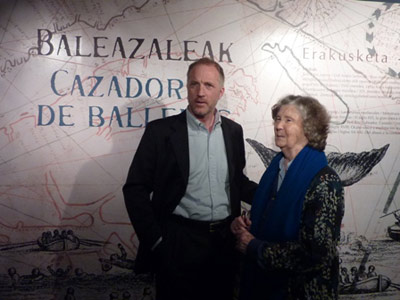basque heritage worldwide

07/22/2013

ADVERTISING
Donostia-San Sebastian. Historian Selma Huxley (London, 1927) is one of the foremost authorities in the field of maritime History of Canada. Her life is closely related to the Basque Country and culture that she got to know through her husband. She moved here in 1972 as a widow with four children to begin her impassioned Basque archival research without any institutional support.
Her work resulted in the discovery of much documentation that allowed her to reconstruct the history of Basque fishing and whaling in Canada. One of the milestones of her career was the discovery, in 1977, of the ship San Juan that sailed in the 16th century from Pasaia and sunk in Red Bay. This and other remains of Basque fishing accounted for the discovery of part of the Canadian story that until then was unknown.
UNESCO Appointment
Now, the appointment of Red Bay as a World Heritage Site by UNESCO is a new recognition of work done by Huxley and other historians such as Robert Gernier to recuperate the history of Basques in Canada and Newfoundland.

[This Basque txalupa was found in the wreckage of the ship San Juan that had been at the bottom of the bay for more than 400 years and can now be seen at the Basque Museum at Red Bay (photo Red Bay National Historic Site of Canada)]
“The declaration of Red Bay as a World Heritage Site by UNESCO is marvelous for Canada as well as for the Basque Country. For Red Bay, it will mean an influx of tourists from all over the world, which is very important since fishing has declined enormously,” the historian told EuskalKultura.com.
Research in the Basque Country
Celebrating this recognition, the Aquarium in Donostia honored Huxley by giving her the Gold Medal, for more than 30 years dedicated to the research for traces of Basques in Newfoundlan. Among her friends and collaborators that gathered there were her son, Michael Barkham, also a historian who grew up in the Basque Country and has continued the Basque archival research in search of documents on fishing and whaling in Canada.
Fruits of this joint research include the testament of Domingo de Luca from Hondarribia dated 1563 written in Newfoundland, the oldest civil document in Canada. “It is a unique document,” Huxley assures “like those of the sale of txalupas and tow testaments that I had found written in Labrador in 1572, 1577 and 1584 respectively."

[Selma Huxley along with her children in Oñati in 1976 (photo ILinazasoro/EuskoMedia)]
Twelve Basque Ports in Canada
Archival research has resulted in an expedition to Canada that concluded with the discovery of Red Bay. “According to the manuscripts whalers frequented nearly 12 ports on this coast among them the old Buttes port and Red Bay as it is known today,” the historian says. “In 1977, I organized an archeological expedition to Labrador and there we found the remains of whaling bases in several ports including Red Bay. Yes, we realized that these archeological discoveries were significant in the early white history of Canada.”
The research, as well as the accompanying archeological excavations, has been very thorough but there still may be surprises to be found. “Thanks to the research that we carried out over the last 40 year we have been able to reconstruct the majority of the aspects of the Basque presence in Terra Nova in the 16th century. This includes, of course, the daily life and work of those sailors. I hope that there are still some surprises!” Huxley concludes.
ADVERTISING
ADVERTISING
ADVERTISING
ADVERTISING
ADVERTISING
© 2014 - 2019 Basque Heritage Elkartea
Bera Bera 73
20009 Donostia / San Sebastián
Tel: (+34) 943 316170
Email: info@euskalkultura.eus